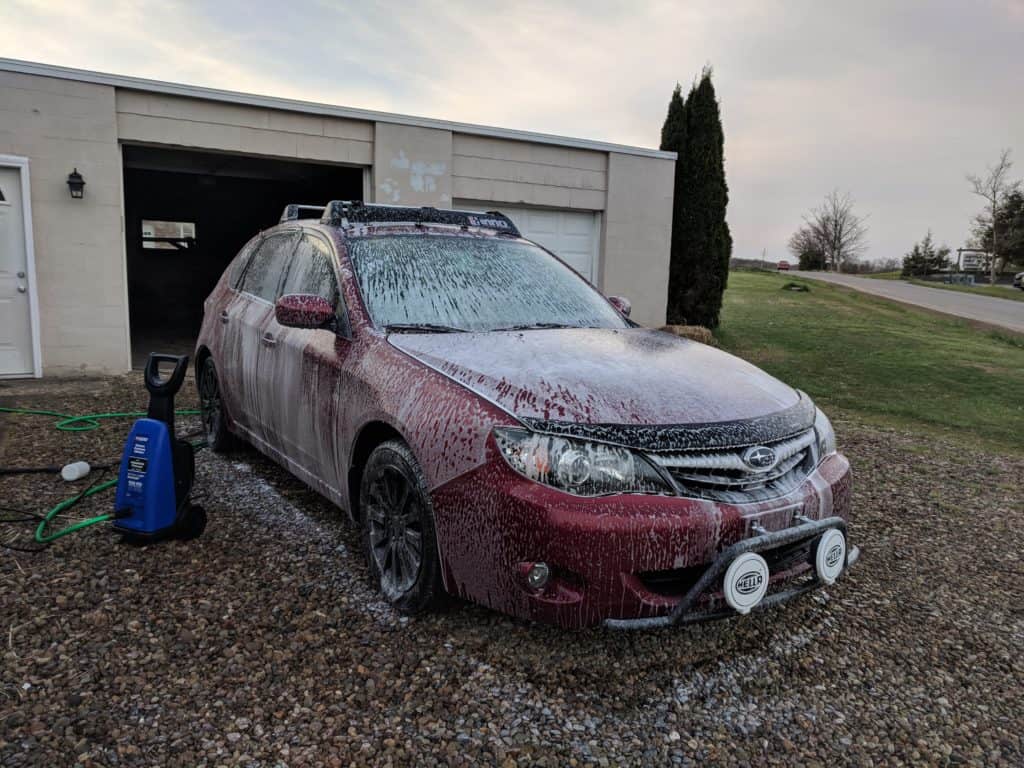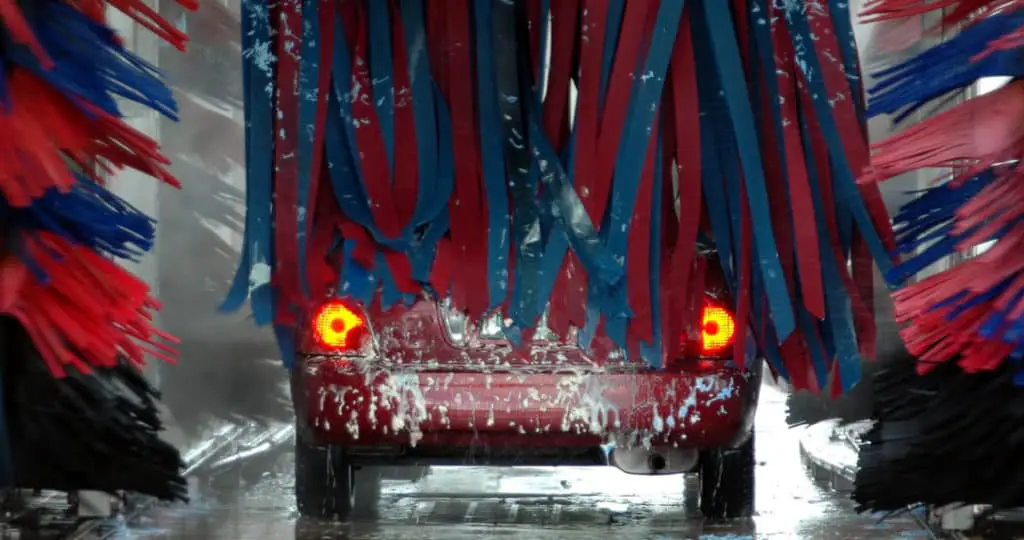- What Is The Two Bucket Car Wash Method (Beginners Guide) - July 2, 2021
- Will Washing Car Remove Wax? What You Need To Know - December 3, 2019
- What Causes Scratches On Car Paint: You Should Know This - April 29, 2019
Last Updated on March 19, 2025 by Nate Schnell
Keeping your car clean isn’t just about appearances—it’s also about maintaining the protection and shine provided by car wax. Waxing a vehicle takes significant effort, so naturally, you’d want to know if your hard work could be undone by simply washing the car.
The short answer is that washing your car using the proper car soap won’t remove wax. However, frequent washing over time might reduce the lifespan of the wax slightly, but it won’t instantly strip it away.
That said, if you use household soaps such as dish soap or laundry detergent, these harsher cleaners can absolutely strip wax from your car’s surface. Sometimes that’s intentional—like when you’re trying to remove old wax from your windshield or paint. But most of the time, you’ll want to avoid these stronger cleaners.
Does Water Alone Wash Away Wax?
Plain water itself won’t typically strip the wax from your car. However, the type of soap you use makes a big difference. If you frequently use foam cannons or foam guns with aggressive pre-wash products designed to remove stubborn stains like bird droppings, tree sap, or tar, you may inadvertently shorten the life of your wax job.
If you’ve recently spent hours detailing your car and carefully waxing the paint, consider using a dedicated, wax-safe car shampoo for your regular washing routine. These soaps gently clean dirt and grime without stripping away that precious protective wax coating you applied.
Can a Pressure Washer Remove Car Wax?
Pressure washers can be safe to use on a waxed car, but you must be careful about their pressure and distance from your vehicle. Pressure washers that deliver extremely high PSI—typically above 1800—can damage wax coatings and potentially harm your paint, especially if the nozzle is positioned too close.
To safely wash a waxed car using a pressure washer, keep the PSI under 1800. Use a nozzle with a wide spray angle, maintain at least a meter distance, and angle it at around 45 degrees. This method will protect both your car’s finish and your wax layer, even when performing an undercarriage wash.
Understanding Car Wash Soap and Why It Matters
You might wonder why you need special soap for your car when you’ve got plenty of household cleaners around. Think about it like this: each type of soap—dish soap, laundry detergent, hand soap—is specially formulated for its specific task. They’re designed to cut through different types of grime and dirt in unique ways, and the same is true for car wash soaps.
Car wash soap is carefully formulated with automotive paint in mind, striking the right balance between cleaning power and gentleness. A good car wash soap, such as Meguiar’s Gold Class Car Wash, effectively removes dirt without damaging your paint or removing protective wax layers.
If you regularly use a proper car soap with microfiber towels and gentle washing techniques, your wax coat will be well-protected, and your car will stay shiny much longer.
What Soaps Actually Remove Wax?
Sometimes, intentionally or not, you’ll find yourself needing to remove wax. The two main categories of soaps known for stripping car wax are household soaps (like dishwashing liquids) and dedicated wax-removal soaps.
Household soaps contain harsh chemicals that aggressively cut through grease and tough stains. While dish soap or laundry detergent might quickly remove stubborn grime or wax, they can also negatively impact your car’s clear coat. Therefore, it’s best to avoid these products for routine car washing.
If your goal is specifically to remove old wax (for example, before applying a fresh coat), opt for a dedicated wax removal soap like Chemical Guys Clean Slate Surface Cleanser. It’s formulated specifically to remove wax and residue safely, leaving a clean surface ready for a fresh wax or sealant application.
How Long Does Car Wax Typically Last?
The durability of car wax depends greatly on the type of wax you use and the conditions your vehicle faces. Traditional carnauba wax generally provides a beautiful deep shine but only lasts around 1 to 4 months. Synthetic waxes (paint sealants), although they might not offer the same depth of shine, typically last significantly longer—anywhere from 4 to 12 months.
Environmental factors, such as weather exposure, sun intensity, road salt, and how often you wash your car, greatly affect this timeline. Regular washing with the correct soap will help preserve wax, whereas frequent exposure to harsh elements or washing with aggressive soaps shortens its lifespan.
How Often Should You Wax Your Car?
At a minimum, waxing your car twice a year is advisable for basic protection. If you’re using carnauba wax or if your car regularly encounters tough conditions like intense sun, winter road salt, or heavy rains, it’s better to wax every three or four months.
A quick test to see if you need to reapply wax is to spray a bit of water onto your car. If it beads up nicely, your wax is still good. If the water starts forming flat puddles rather than distinct beads, your wax has worn away, and it’s time to reapply.
Carnauba vs Synthetic Wax: What’s the Difference?
Carnauba wax, derived from a Brazilian palm tree, remains popular for providing an intense, deep shine and warmth. Enthusiasts often choose it because it makes the car look exceptionally glossy and vibrant. Its downside is that it doesn’t last as long—typically only a few months at most.
Synthetic waxes, also known as sealants, are chemically engineered products designed primarily for durability. While they won’t offer quite the same depth or warmth in appearance as carnauba waxes, they excel at long-term protection, often lasting up to a year.
Both wax types provide similar levels of protection for your paint—your choice essentially comes down to aesthetics versus durability.
Why Regular Waxing Is Worth Your Time
Waxing isn’t just about making your car look good; it also has practical benefits. For starters, wax creates a protective barrier against UV rays, dramatically reducing the risk of fading or peeling paint caused by prolonged sun exposure.
Moreover, wax fills in minor imperfections and roughness, creating a smoother, glossier finish that’s harder for dirt and debris to stick to. This not only makes your car easier to clean but also prevents contaminants from embedding deeply into the paint, preserving its pristine condition.
Ultimately, choosing the right soap and cleaning technique ensures your wax job lasts longer. By understanding what removes wax and how to protect your vehicle effectively, you can keep your car looking its best while minimizing the hassle of frequent waxing.



